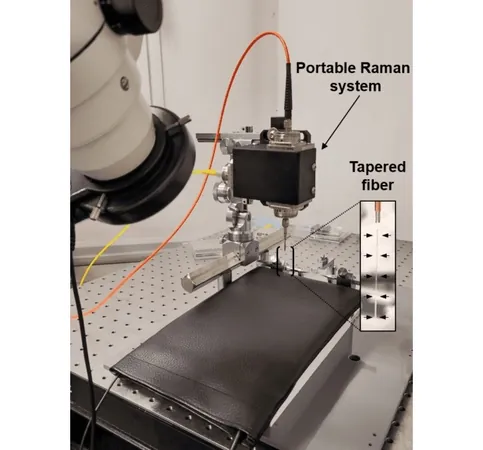
Revolutionary ‘Molecular Lantern’ Technique Illuminates Brain Cancer Detection with Remarkably Thin Probe
2025-01-01
Author: Wei Ling
Introduction
In a groundbreaking advancement in biomedical research, scientists have unveiled a pioneering technique called the "molecular lantern" that promises to transform the way we monitor molecular changes in the brain, particularly those caused by cancer and neurological disorders. This innovative method involves the non-invasive use of light through an ultra-thin probe, specifically designed to navigate deeply into the brain without causing any damage.
Development of the Technique
Developed by a collaborative team of researchers from the Spanish National Research Council (CSIC) and the Spanish National Cancer Research Centre (CNIO), this technique utilizes a probe that is less than 1 mm in diameter, with a tip that is merely a micron thick—about one thousandth of a millimeter. Remarkably, this size is significantly smaller than a human hair, making the probe nearly invisible. As a result, it can be safely inserted into brain tissue, opening new avenues for research without the need for surgical alterations that could compromise the integrity of brain function.
How It Works
What sets the molecular lantern apart from existing methods like optogenetics is its ability to obtain vital information without pre-altering brain tissues. The molecular lantern operates using vibrational spectroscopy based on the Raman effect, which allows scientists to observe unique spectral "fingerprints." These fingerprints reveal the intricate chemical composition of brain tissue, enabling researchers to monitor molecular alterations associated with various conditions, including primary and metastatic tumors as well as traumatic brain injuries.
Future Applications and Potential
The innovations don’t stop there. The research team has ambitious plans to leverage this technology to differentiate between cancer types by analyzing mutational profiles and origins. They have also employed the molecular lantern technique to study areas surrounding traumatic brain injuries that may predispose individuals to epilepsy, identifying distinct vibrational signatures that signify varying susceptibilities to seizures. This discovery highlights the technique's potential to categorize various brain pathologies by using advanced computational algorithms, possibly enhanced by artificial intelligence.
Expert Opinion
"This technology allows us to study the brain in its natural state without the need for prior manipulation," shared Manuel Valiente from the CNIO. "The integration of vibrational spectroscopy alongside other brain activity recording techniques and AI-driven data analysis could lead us to discover new diagnostically relevant markers. This synergy will be crucial in developing advanced neurotechnologies tailored for innovative medical applications."
Conclusion
While the molecular lantern is still in the research phase and not yet ready for clinical use, it boasts significant promise as a powerful tool in the detection and analysis of brain-related conditions. As researchers continue to refine this technology, it could pave the way for earlier diagnoses and improved treatment strategies for brain cancer and other neurological diseases, ultimately revolutionizing patient care and outcomes.
Stay Tuned
Stay tuned as we bring you updates on this remarkable technology that merges spectroscopy and cutting-edge research in the ongoing fight against brain cancer and severe neurological conditions. The future of brain health could indeed be brighter with these advancements!




 Brasil (PT)
Brasil (PT)
 Canada (EN)
Canada (EN)
 Chile (ES)
Chile (ES)
 Česko (CS)
Česko (CS)
 대한민국 (KO)
대한민국 (KO)
 España (ES)
España (ES)
 France (FR)
France (FR)
 Hong Kong (EN)
Hong Kong (EN)
 Italia (IT)
Italia (IT)
 日本 (JA)
日本 (JA)
 Magyarország (HU)
Magyarország (HU)
 Norge (NO)
Norge (NO)
 Polska (PL)
Polska (PL)
 Schweiz (DE)
Schweiz (DE)
 Singapore (EN)
Singapore (EN)
 Sverige (SV)
Sverige (SV)
 Suomi (FI)
Suomi (FI)
 Türkiye (TR)
Türkiye (TR)
 الإمارات العربية المتحدة (AR)
الإمارات العربية المتحدة (AR)